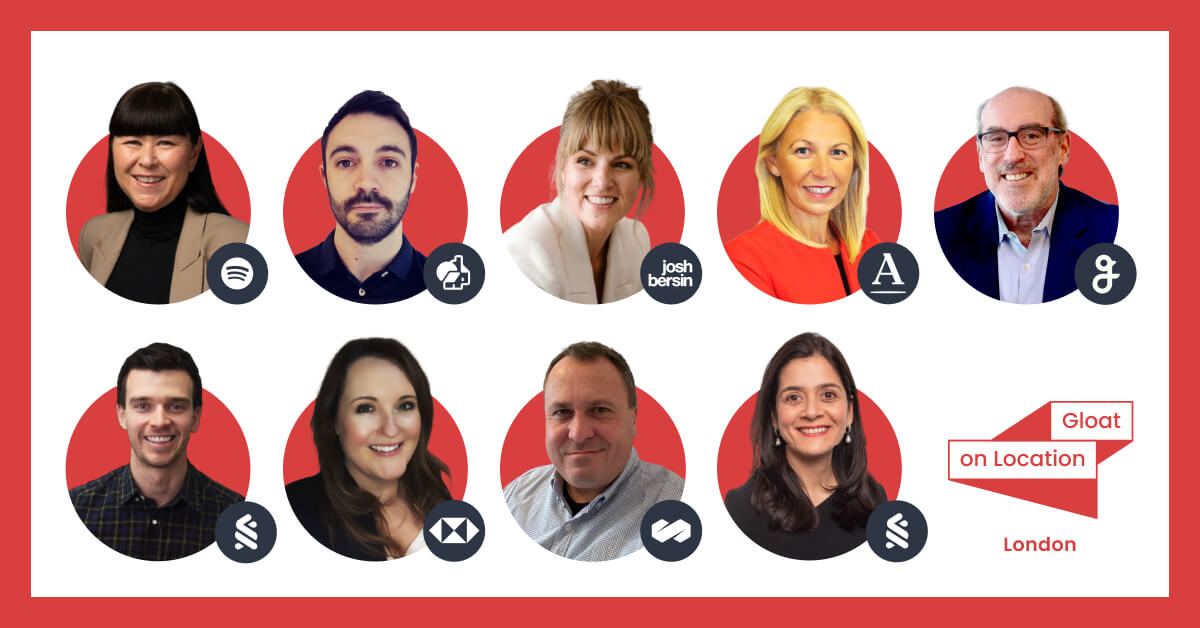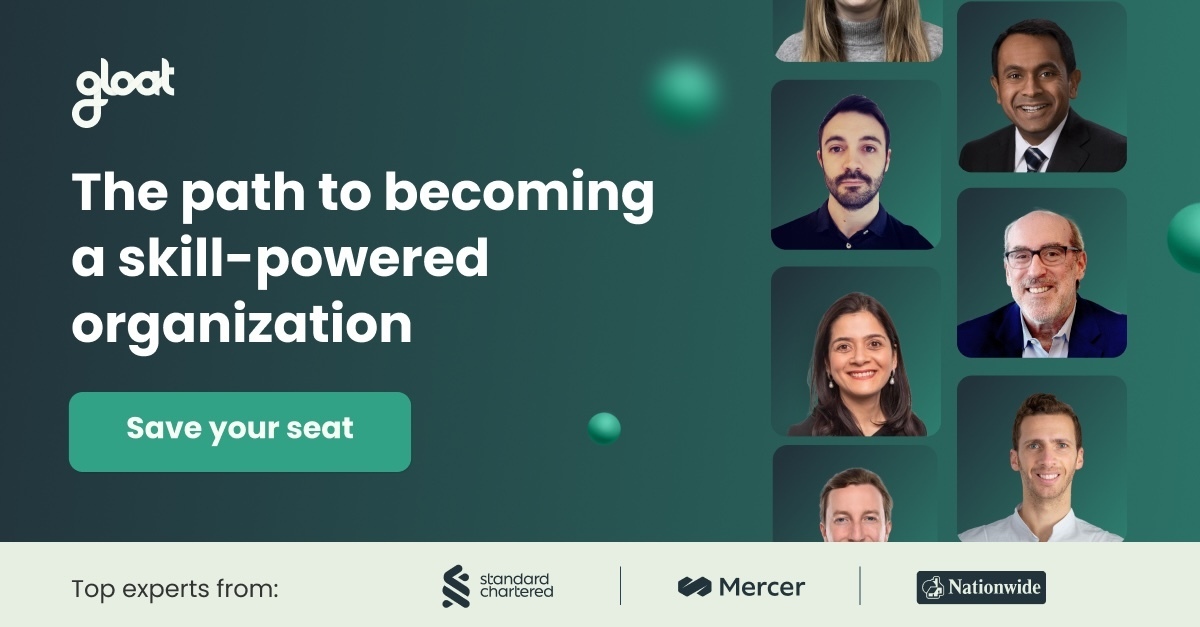Top skills transformation tips from Gloat on Location London
Get a recap of the eye-opening advice our experts shared during Gloat on Location London

Skills transformations are rising to the top of leaders’ agendas—and it’s easy to understand why. Many workforces are missing out on crucial capabilities, with 87% of businesses acknowledging that they currently have skill gaps or anticipate they will in the next few years. The dwindling supply of employees with in-demand skills comes at a high cost; Korn Ferry predicts that by 2030 there will be a global human talent shortage of 85 million people—which could result in about $8.5 trillion in unrealized annual revenues.
Rather than losing out on profits, leading companies are launching skills-centric transformations to equip their workforces with the in-demand capabilities their businesses rely on. But while many organizations are embarking on these important change journeys, there are only a handful of visionary leaders who’ve already architected winning transformations and know what these strategies require firsthand.
We decided to bring these trailblazing executives together and put them in conversation with some of the most renowned analysts and industry experts at Gloat on Location London. To no one’s surprise, their conversations were filled with eye-opening insights and little-known agile change secrets. In fact, their advice was so good we’ve decided to share the most important takeaways so that visionary leaders across the globe can use them to level up their organizations’ skills transformations.
5 key takeaways from Gloat on Location London that every HR leader needs to hear
Over the course of 3.5 hours, Tanuj Kapilashrami, Katarina Berg, Mark Jackson, Mel Lee, Watson Stewart, Marcus Downing, Claire Tunley, and Laurie Padua took to the Gloat on Location stage to explore the ins and outs of successful skills transformations. From a masterclass in workforce planning to tips for introducing AI-powered systems in regulated sectors, here are some highlights from our time at The Gherkin:
#1. Understand the skills your business will need in the future—and those it won’t
Most leaders recognize that skill gaps pose a growing threat to their organizations, but only 40% of employees believe their companies offer upskilling opportunities. While any skill-building pathways are a step in the right direction, the most impactful initiatives will prioritize the capabilities that promise to grow in importance as the working world continues to evolve.
Mark Jackson, Head of Future Workforce at Nationwide, knows the value of prioritizing future-fit skills firsthand. “The key is identifying those future skill gaps,” he notes. “If this is the key thing that’s going to make a difference to that part of the business for our customers, then let’s go and work out the best way to invest in it. We can give a heads up to some of our business areas that actually, this is a good way we can create learning pathways.”
In addition to understanding which capabilities to prioritize, Spotify’s CHRO Katarina Berg believes AI-powered skills intelligence systems will help leaders identify and deprioritize skill needs that are on the decline. “I think on the skills side, for the first time, we’ve been talking about upskilling and cross-skilling and all that. But I think, you know, the new technology will also help people to off-skill in a way, because a lot of things that we really needed in most organizations might not be even a relevant skill, and it will also change faster.”
#2. Successful skills transformations will require both AI and human inputs
No transformation discussion would be complete without considering what role AI will play in bringing these strategies to life. Standard Chartered Bank’s Chief Talent and Strategy Officer Tanuj Kapilashrami is enthusiastic about the potential these systems have, noting, “I am a massive net positive on Gen AI. I think human collaboration and what it means for the transformation of the business is going to be what the next decade of HR professionals will be focused on. To me, it’s not just about slapping the technology. It’s about human-AI collaboration.”
Jackson illustrates how powerful these human-machine partnerships can be when describing how Nationwide uses both technology and crowdsourcing to evaluate the skills within its workforce. “…we very much believe in organically crowdsourcing the skills of our workforce, rather than saying, ‘Well, if you’re in this job, these must be the five or six skills you have.’ Well, who’s decided that if you’re in that type of organization? Maybe one or two people within the HR function. How are they the best informed to make the decision if those are the skills?” he says. “You can start to use AI now to infer some of this information. But crowdsourcing as much as possible is telling us what actually our colleagues are thinking and saying are the skills they have and also the skills they’re developing. And that’s one of the key elements we find within our [agile workforce OS].”
#3. Every business can use AI—even companies in regulated sectors
As many organizations race to embrace new AI use cases, some leaders may fear that regulations within their industry will hold their companies back from harnessing these innovations. Given his role as Global Head of Talent at Standard Chartered Bank, Watson Stewart has plenty of experience navigating these challenges—and believes leaders can overcome them, as long as they work with the right partners and vendors.
“One way to see innovation in a regulated sector is: ‘Oh, it’s just going to be impossible. It’s too hard to do. You know it’s never going to happen.’ But actually, once we started to partner really closely with our colleagues in key functions within our organization—whether that be Legal or Compliance or Risk—and even the regulators themselves, actually, what we created was a really strong partnership of making it better together. It wasn’t about being really subservient to regulation or risk stakeholders but showcasing in many ways, with partners like Gloat, to say, ‘Look this is the business opportunity we’re going after. This is what we can make possible. Here is the risk-based judgment and our approach to how we’re going to do it. Can you help us?’”.
#4. Skills and AI will help leaders do more with less
As economic turbulence continues, many leaders face mounting pressure to execute more with fewer resources. Rather than relying on costly external hiring processes, visionary executives are harnessing AI-powered systems like an agile workforce OS to dynamically align talent to open projects and gigs so employees can put their skills to use across their organizations. These talent-sharing initiatives have some pretty impressive pay-offs, as HSBC’s Head of HR Strategy & Transformation Mel Lee knows firsthand. “We started the journey with Gloat [our agile workforce OS provider] a number of years ago now. But if I look back over the last two or three years, we have unlocked the equivalent of over three hundred thousand hours worth of capacity. We’ve democratized what you would normally call on-the-job learning opportunities,” she notes.
As a Partner at Mercer, Markus Downing is very familiar with the efficiency challenges that businesses are facing—and the tools and strategies these organizations will need to overcome them. “The business is thinking about productivity. We’ve had a couple of years of post-pandemic growth, of people taking the brakes off, spending the money, and now they’ve gotten to a place where perhaps growth isn’t as aspirational as they’ve wanted. And they’re saying to themselves, ‘How do we do more with the same or do the same with less resources?’” he says. “And therefore, talent marketplaces and skills come into the fore in terms of how we get the agility of moving people around to the right work at the right place at the right time by looking and atomizing work in terms of skills rather than jobs.”
#5. Leaders must level up their skill-building efforts—before it’s too late
Although some leaders may feel tempted to delay their transformations in an effort to learn from peers and competitors, no organization can afford to put their skills journey on the back burner. Laurie Padua, Managing Director at AMS, shares findings that illustrate today’s transformation imperative, noting, “LinkedIn has produced a huge amount of data on the subject. They’ve stated that 25% of skills in jobs have changed from 2015 and they expect that to double by 2027. So we’re all on this journey together.”
Adding on, Claire Tunley, Chief Executive of the Financial Services Skills Commission, emphasizes just how critical the next decade will be when it comes to building in-demand skills. “We know that in the next ten years, a quarter of employees are going to leave because of retirement, attrition, and career choices, and we know that we can’t fill those spaces with graduates and apprenticeships,” she notes. “16% of our sector doesn’t have full capability for the job they’re doing and that will just grow because as job roles change, we need to keep skills up to date and we haven’t been very good at that as a country or as a sector for the last 10 to 20 years. So that need for high-level skills and people in our sector to have the skills we need is not going away. And that’s something that when we talk to our C-suite people in companies, they immediately get it.”
Want more expert-backed skills transformation insights? Check out the first episode of Gloat Insider Sessions, to preview the key findings from The Skills Powered Organization with authors Ravin Jesuthasan and Tanuj Kapilashrami.





